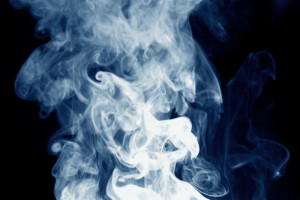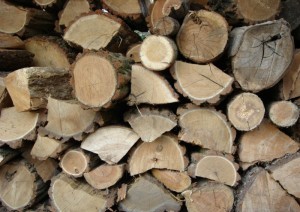by Billy Sweet | Mar 26, 2016 | Seasoned Firewood, wood burning
Where There’s Smoke, There’s Fire
Yes, smoke generally means a fire exists. However, in your fireplace or furnace, smoke usually indicates a less-than-efficient fire. If your fireplace is smoky, you most likely have a problem with your fuel, or with your venting system.

Proper Fuel
It is very important to choose properly seasoned wood to burn in your fireplace or furnace. If your wood is green or wet it will burn slower, less hot, and maybe incompletely. When green or wet wood is burned it often doesn’t burn hot enough to push the smoke up the chimney, causing the smoke to stall, and fall back down.
Improper Use or Maintenance
If your fireplace is releasing excess smoke into your home, you should first check the damper. The damper should be open in order to allow the smoke to rise up the chimney. If the damper lever is opened, the opening may be blocked by soot buildup or debris. Like the damper, if the chimney isn’t routinely cleaned, layers of soot can prevent the smoke from rising up the chimney and out of the home. You can schedule your routine chimney sweeping to have your chimney flue and damper cleaned thoroughly.
Venting Problem
In order for gas to leave the home through the chimney, it has to pull from inside the home. When air is removed from the home it must be replaced. Modern homes are built tight, so air isn’t pulled from outside as the gases attempt to rise up the chimney. Even adding insulation or replacing windows in the home can create a smoke problem for this reason. An easy way to fix this problem is to open a window in another part of the home.
Also, it’s important to note that other home appliances can compete with the ventilation of the chimney. Even something as simple and harmless as a ceiling fan can compete with your chimney. Also, a leaky chimney can disrupt the draft of your fireplace.
Regardless of the cause, no home or business owner wants to deal with a smoke problem in the fireplace or furnace. Not only is it unpleasant, but it can cause respiratory issues if not corrected, and can also be a fire hazard. If the heated gases aren’t moving up the chimney, they can stall in the chimney flue and cause a flue fire. Because your chimney system is important, and the safety of your family and property are our top priority at Billy Sweet Chimney Sweep, we recommend calling a professional if a smoking fireplace persists. Schedule your appointment today.
For more information about why your chimney isn’t working, check out the Chimney Safety Institute of America (CSIA) and “100 Reasons Your Fireplace Doesn’t Work”.
by Billy Sweet | Dec 19, 2014 | Seasoned Firewood
Staying warm this winter requires the proper preparation. For maintaining a comfortable temperature inside the home, this could involve starting a fire in the wood burning stove or fireplace. To ensure the hottest, most fuel efficient fire, you have to start off with the best firewood.

The most critical trait to consider in your firewood is the extent of its seasoning. To be seasoned is to have been allowed to dry fully by being stored indoors for a specific amount of time. Essentially, seasoned wood means dry wood. How long the wood needs to completely season varies based on the type of wood. Softer varieties of wood may season in six month, while hardwoods can require as long as two years to achieve completer dryness.
Preferably, any wood you burn should have been allowed to season completely prior to burning. To follow this guideline, you have two options. First, you can purchase wood that is already fully seasoned. This wood can be burned right away for the best fuel efficiency, but you may have a hard time finding it. If you do find well seasoned wood for sale, it probably costs significantly more than the wet wood. The other option is to purchase wet wood and allow it to season in a shed or garage. This option saves you upfront costs, but it involves planning one or two years in advance. Either option you choose, you should always burn seasoned wood. A lot of energy is wasted on wet wood by boiling away the trapped moisture, so you end up with a colder fire, excess smoke, more spent on fuel, and incompletely burnt wood.
Incompletely burnt wood creates health risks because it produces a black, tarry material called creosote. Initially a vapor as it exits the fire, creosote condenses inside the chimney. Over time the creosote can build up and restrict the air flow through the chimney, which can lead to poor indoor air quality. The high flammability of creosote can also result in a chimney fire from a mere stray ember. Luckily, avoiding this risk is as easy as burning seasoned wood and having an annual chimney sweep and inspection done.
Just because you purchase seasoned wood does not mean it stays seasoned forever. How you store the wood after you buy it and before you burn it determines whether or not it remains fully seasoned. The ideal storage arrangement involves stacking the wood, with a depth of only one log, in a shed or other outdoor building. Leave the wood uncovered to prevent condensation. If the wood must sit outside, protect it from the elements by creating a sturdy roof for it. A piece of sheet metal works well. Be sure to leave the sides of the stack uncovered to encourage air flow.
If you have any questions about firewood or if you need to schedule a chimney sweep or inspection, contact Billy Sweet Chimney Sweep to speak with an expert.
by Billy Sweet | Nov 18, 2013 | Uncategorized, Wood Stove
Choosing the Right Firewood for Your Fireplace
Are you aware that, just like love that’s right for you, there’s the perfect wood for your fireplace too? Yes, your fireplace also requires attention and care. One way to do so is to burn certain types of wood that suits it and you. By carefully selecting the best wood, it can provide the most efficient fire to warm your cold days as well as ensure the safety of your home. You just have to find out what they are.

You should avoid wood that is wet or too green. Typically, wood needs to be seasoned for at least six months.
Points to Remember
It’s important to know that too much moisture in wood reduces its burning efficiency. The smoke that it produces cannot compensate the heat needed in the home and can cause the build-up of creosote in your chimney since it directly goes there. The harmful chemicals it contains can put your lives in danger too.
We all want the best type of wood especially during the holidays. There are those who prefer more heat and there are those who would rather want lower heat intensity. The wood plays a hand in the intensity of the flame. Another important note to remember, regardless of the type of wood and the characteristics it bestows, is that the wood should be seasoned. The drying process usually takes six to twelve months. Also keep in mind that in order to maintain the natural capability of the wood to produce fire, it has to be properly stored.
Types of Firewood
Trees are either hardwood or softwood. They both produce a limited amount of heat. Both can help you enjoy the rest of the holiday season with the exact warmth you desire. Depending on the kind of fire and the amount of heat you want, you can pick from among these well-seasoned wood.
Softwood can produce a crackling effect on your fire. The pop and crackle sound is something to look out for when the wood starts to burn. It has this vibrant aroma that is just right for the cold winter nights. Pine has all the characteristics a crackling fire needs. Just make sure there are protective screen doors so that no one is harmed when it starts to pop. Softwood can burn quickly, cleanly and more efficiently thus creating a quick burning fire. On the downside, it does not provide too much heat compared to that of hardwood. But there are some who prefer their wood that way. This type of wood can be ignited right away. Cedar and White Spruce are examples of wood used for this kind of fire.
Hardwood, on the other hand, gives off more heat because of its thickness. They have the highest British Thermal Unit content which doubles the output of heat compared to that of softwood. They burn more slowly thus bringing heat to the highest level possible. There is also minimal smoke produced with this type of wood. The only disadvantage of this type of wood is that it takes more time to ignite a fire with it. Some examples are Maple and Oak.
Regardless of the type of wood you prefer, it’s always best to make sure that your fireplace and chimney are intact and safe from any debris or damage. Annual chimney inspection and sweeping is highly recommended. If you are already looking for one, the certified experts of Billy Sweet Chimney Sweep is willing and ready to take care of your fireplace and chimney for you.
by Billy Sweet | Sep 19, 2013 | Chimney Maintenance
Where is that cold air coming from?
We come up with all sorts of creative ways of dealing with drafts—anything to keep that sharp, cold air out of our home. Dealing with chimney drafts, however, is a little trickier than sealing windows and doors to lower the energy bill.

A certified sweep can help determine the origin of the draft problem.
There are many things that can cause drafts, and a certified sweep from Billy Sweep Chimney can save you time and money by getting straight to the source of the problem.
Here are a few of the things that can cause chimney drafts:
Size is important. For every 10sq in of firebox, 1in of flue is needed. If this ratio is off, the chimney won’t be able to do its job. In some cases, having a smoke guard installed can resolve this. The height of the chimney also plays into draft issues. Hot air rises, and more heat can be generated inside a taller chimney, which increases the odds that the smoke will make its way out.
Blockage. Debris, birds, animals, leaves, etc. can become trapped inside your chimney. Creosote buildup can also cause blockage, and is also a serious fire hazard.
Negative air pressure. Appliances such as a vacuum, clothes dryer, or furnace all take air from the home. If there isn’t enough, air will get pulled in through the chimney.
Here are some things you can do on your own to reduce drafts.
- Open the damper.
- Turn it off. Turning off any appliance that creates an air vacuum in the home can help with drafts.
- Open a window. New homes are built to be more efficiently airtight, so there can often be air flow issues when operating a fireplace. If your home is under 25 years old, open a window when operating the fireplace.
- Only use dry, seasoned wood.
- Place fire grate as close to the chimney’s back wall as possible. This ensures the fire is positioned correctly under the chimney.
If these are unsuccessful, give us a call to schedule an appointment. We serve Boston and North Shore (and surrounding areas), as well as Portland, Maine.




